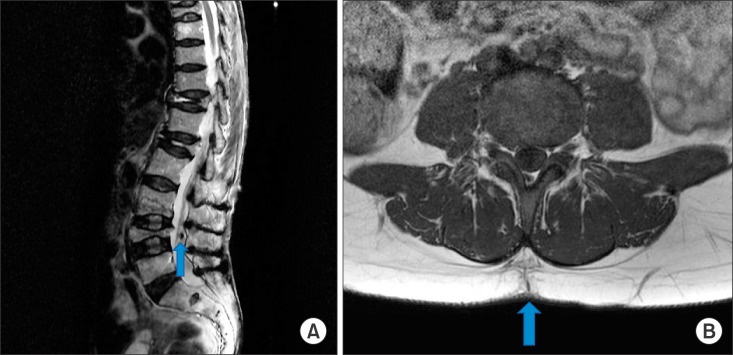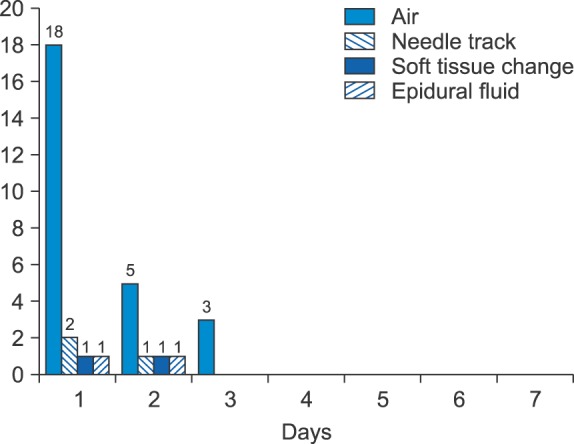Korean J Pain.
2017 Oct;30(4):281-286. 10.3344/kjp.2017.30.4.281.
Effect of epidural corticosteroid injection on magnetic resonance imaging findings
- Affiliations
-
- 1Department of Anesthesiology and Pain Medicine, Institute of Medical Sciences, Kangwon National University Hospital, School of Medicine, Chuncheon, Korea. arim14@kangwon.ac.kr
- 2Department of Radiology, Institute of Medical Sciences, Kangwon National University Hospital, School of Medicine, Chuncheon, Korea.
- 3Department of Anesthesiology and Pain Medicine, Institute of Medical Sciences, Hallym University Hospital, School of Medicine, Chuncheon, Korea.
- KMID: 2392905
- DOI: http://doi.org/10.3344/kjp.2017.30.4.281
Abstract
- BACKGROUND
Magnetic resonance imaging (MRI) of the spine is the preferred diagnostic tool for pathologic conditions affecting the spine. However, in patients receiving epidural corticosteroid injection (ESI) for treatment of spinal diseases, there is a possibility of misreading of MR images because of air or fluid in the epidural space after the injection. Therefore, we defined the characteristics of abnormal changes in MRI findings following an ESI in patients with low back pain.
METHODS
We reviewed the medical records of 133 patients who underwent MRI of the lumbar spine within 7 days after ESI between 2006 and 2015.All patients were administered an ESI using a 22-gauge Tuohy needle at the lumbar spine through the interlaminar approach. The epidural space was identified by the loss of resistance technique with air.
RESULTS
The incidences of abnormal changes in MRI findings because of ESI were 54%, 31%, and 25% in patients who underwent MRI at approximately 24 h, and 2 and 3 days after ESI, respectively. Abnormal MRI findings included epidural air or fluid, needle tracks, and soft tissue changes. Epidural air, the most frequent abnormal finding (82%), was observed in 41% of patients who underwent MRI within 3 days after injection. Abnormal findings due to an ESI were not observed in MR images acquired 4 days after ESI or later.
CONCLUSIONS
Pain physicians should consider the possibility of abnormal findings in MR images acquired after epidural injection using the interlaminar approach and the loss of resistance technique with air at the lumbar spine.
Keyword
MeSH Terms
Figure
Reference
-
1. Kwon WK, Kim AN, Lee PM, Park CH, Kim JH. Needle tip position and bevel direction have no effect in the fluoroscopic epidural spreading pattern in caudal epidural injections: a randomized trial. Pain Res Manag. 2016; 2016:4158291. PMID: 27445609.
Article2. Manchikanti L, Staats PS, Nampiaparampil DE, Hirsch JA. What is the role of epidural injections in the treatment of lumbar discogenic pain: a systematic review of comparative analysis with fusion. Korean J Pain. 2015; 28:75–87. PMID: 25852828.
Article3. Manchikanti L, Singh V, Pampati V, Falco FJ, Hirsch JA. Comparison of the efficacy of caudal, interlaminar, and transforaminal epidural injections in managing lumbar disc herniation: is one method superior to the other. Korean J Pain. 2015; 28:11–21. PMID: 25589942.
Article4. Lee JY, Lee SM, Sim WS, Ahn HJ, Park MH, Lim HY, et al. False loss of resistance in cervical epidural injection: the loss of resistance technique compared with the epidrum guidance in locating epidural space. Pain Physician. 2016; 19:131–138. PMID: 27008286.5. Gracia J, Gomar C, Riambau V, Cardenal C. Radicular acute pain after epidural anaesthesia with the technique of loss of resistance with normal saline solution. Anaesthesia. 1999; 54:168–171. PMID: 10215712.
Article6. Alsaleh K, Ho D, Rosas-Arellano MP, Stewart TC, Gurr KR, Bailey CS. Radiographic assessment of degenerative lumbar spinal stenosis: is MRI superior to CT. Eur Spine J. 2017; 26:362–367. PMID: 27663702.
Article7. Kim TS, Shin SS, Kim JR, Kim DY. Air bubbles mimic disc herniation in MRI after cervical epidural block. Korean J Pain. 2010; 23:202–206. PMID: 20830267.
Article8. Ammirati M, Perino F. Symptomatic air trapped in the spine after lumbar epidural corticosteroid injection. Case report. J Neurosurg Spine. 2006; 5:359–361. PMID: 17048774.
Article9. Davidson EM, Sklar EM, Ginosar Y, Abdi S, Bhatia RG, Garcia L, et al. Evaluation of magnetic resonance imaging following neuraxial steroid administration: does epidural injection produce pathologic findings. Reg Anesth Pain Med. 2008; 33:326–331. PMID: 18675743.
Article10. von Rothenburg T, Drescher R, Koester O, Schmid G. Magnetic resonance imaging of the lumbar spine after epidural and nerve root injection therapy: evaluation of soft tissue changes. Clin Imaging. 2006; 30:331–334. PMID: 16919554.
Article11. Davidson EM, Sklar E, Bhatia R, Garcia L, Arheart KL, Ginosar Y, et al. Magnetic resonance imaging findings after uneventful continuous infusion neuraxial analgesia: a prospective study to determine whether epidural infusion produces pathologic magnetic resonance imaging findings. Anesth Analg. 2010; 110:233–237. PMID: 19520756.
Article12. Choi JH, Hong JY, Suh SW, Yang JH, Park SY, Park JH, et al. What is the role of epidural steroid injections in lumbar spinal disease with moderate disability? Pain Physician. 2016; 19:293–298. PMID: 27228516.13. Tomkins-Lane CC, Conway J, Hepler C, Haig AJ. Changes in objectively measured physical activity (performance) after epidural steroid injection for lumbar spinal stenosis. Arch Phys Med Rehabil. 2012; 93:2008–2014. PMID: 22659537.
Article14. Cameron CM, Scott DA, McDonald WM, Davies MJ. A review of neuraxial epidural morbidity: experience of more than 8,000 cases at a single teaching hospital. Anesthesiology. 2007; 106:997–1002. PMID: 17457132.15. Choi JW, Lim HW, Lee JY, Lee WI, Lee EK, Chang CH, et al. Effect of cervical interlaminar epidural steroid injection: analysis according to the neck pain patterns and MRI findings. Korean J Pain. 2016; 29:96–102. PMID: 27103964.
Article16. DeFroda SF, DePasse JM, Eltorai AE, Daniels AH, Palumbo MA. Evaluation and management of spinal epidural abscess. J Hosp Med. 2016; 11:130–135. PMID: 26540492.
Article17. Patel AR, Alton TB, Bransford RJ, Lee MJ, Bellabarba CB, Chapman JR. Spinal epidural abscesses: risk factors, medical versus surgical management, a retrospective review of 128 cases. Spine J. 2014; 14:326–330. PMID: 24231778.
Article18. Ikushima I, Hirai T, Korogi Y, Norio M, Koganemaru M, Suga R, et al. Spinal MR findings in continuous epidural analgesia without infection. AJNR Am J Neuroradiol. 2005; 26:991–995. PMID: 15891149.19. Stevens R, Mikat-Stevens M, Van Clief M, Schubert A, Weinstein Z. Deliberate epidural air injection in dogs: a radiographic study. Reg Anesth. 1989; 14:180–182. PMID: 2491280.20. Maes R, Morrison WB, Parker L, Schweitzer ME, Carrino JA. Lumbar interspinous bursitis (Baastrup disease) in a symptomatic population: prevalence on magnetic resonance imaging. Spine (Phila Pa 1976). 2008; 33:E211–E215. PMID: 18379391.
- Full Text Links
- Actions
-
Cited
- CITED
-
- Close
- Share
- Similar articles
-
- Chronic Spinal Epidural Hematoma due to Repeated Epidural Block: A Case Report
- Epidural hematoma treated by aspiration after transforaminal epidural steroid injection - A case report -
- Serratia marcescens Spinal Epidural Abscess Following Caudal Epidural Injection
- Motor Weakness after Caudal Epidural Injection Using the Air-acceptance Test
- Comparison of Therapeutic Effect between Continuous Epidural Injection with Catheter and Intermittent Epidural Injection without Catheter in Patients with Low Back Pain



